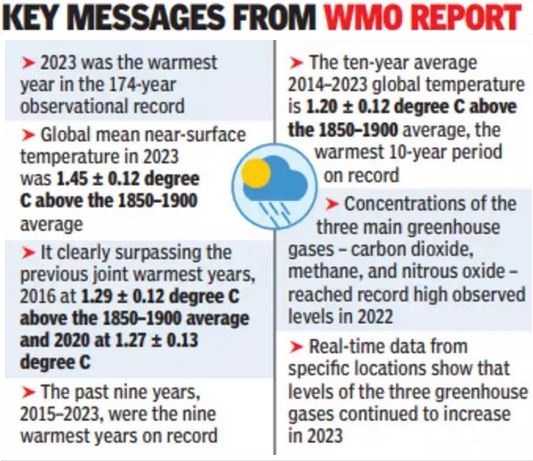|
|
||
|
21 March 2024 |
||
|
- Exploring Data Marketplaces: A New Horizon
- Highlights of the Patent (Amendment) Rules of 2024
- Managing Solar Waste: Challenges and Solutions
- Insights from the State of the Global Climate Report of 2023
- Pebanista Yacuruna

- Exploring Data Marketplaces: A New Horizon

Introduction
The recent release of the National Data Governance Framework Policy (NPD Framework) by the Ministry of Electronics and Information Technology (MeiTY) marks a significant stride towards optimizing data utilization in India’s digital landscape.
Context
India’s aspiration to become a $5 trillion economy is intricately linked with the effective use of data, as evidenced by projections indicating a potential $450-500 billion boost to the GDP by 2025 through data and artificial intelligence (AI) integration, as per a NASSCOM report.
Understanding Data Types
Distinguishing between Personal Data and Non-Personal Data (NPD), the latter, devoid of personal identifiers, holds promise as a societal asset or ‘public good’, essential for enhancing public service delivery and informed decision-making.
Significance of Non-Personal Data
Non-Personal Data (NPD) is poised to revolutionize various sectors, including meteorology, infrastructure planning, transportation, and employment, by offering predictive insights crucial for policy formulation and optimization.
Challenges and Concerns
Despite its potential, NPD governance faces challenges, ranging from privacy and security concerns to the lack of actionable guidance within the NPD Framework, compounded by the absence of clear legislation and operational frameworks.
Government Initiatives
Efforts like Telangana’s Agriculture Data Exchange platform and the India Urban Data Exchange (IUDX) exemplify attempts to streamline data exchange and bolster decision-making in critical sectors such as agriculture and urban planning.
Addressing Challenges
Critical evaluation and enhancement of the NPD Framework are essential, drawing insights from international practices and involving stakeholders from various sectors to ensure effective governance of non-personal data.
Conclusion
Through regulatory frameworks for data exchanges, learning from global examples, and fostering inclusive stakeholder consultations, India can overcome challenges and maximize the societal benefits of data utilization, thereby advancing its digital ambitions and economic growth trajectory.
- Highlights of the Patent (Amendment) Rules of 2024
Introduction:
The Gazette of India has recently published the Patent (Amendment) Rules, 2024, signifying significant alterations in India’s patent framework.
This update comes after a notable year for intellectual property rights (IPR) in India, highlighting the nation’s dedication to fostering innovation and creativity.
Landmark Achievements:
- The Indian Patent Office has reached a milestone by granting over 1 lakh patents in a single year, marking the first time such a feat has been accomplished.
- Patents have been granted across various sectors, with electrical and related fields leading the tally, followed by mechanical, chemical sciences, and biotech categories.

Key Amendments Introduced:
1. Revised Timeline for Request for Examination (RFE): The period for submitting an RFE has been shortened from 48 months to 31 months from the earliest priority date.
2. Streamlined Application Processes: Applicants are now required to furnish details of corresponding applications only twice using Form 3.
3. Introduction of ‘Certificate of Inventorship’: A new provision has been introduced to acknowledge the contributions of inventors to patented innovations.
4. Reduction in Advance Renewal Fees: A 10% discount on renewal fees is offered for electronic payments made in advance for a minimum of four years.
5. Decreased Frequency of Patent Working Statements: The requirement to file statements of working patents has been reduced from annually to once every three financial years.
6. Enhanced Authority of Controller: The Controller is now empowered to extend specified periods and excuse delays for up to six months.
7. Amendments to Opposition Procedures: Adjustments have been made to time frames for submitting recommendations by an Opposition Board and response periods for applicants in both pre-grant and post-grant opposition procedures.
Understanding Patents:
- A patent grants exclusive rights to inventors or assignees, allowing them control over the use, sale, or importation of their inventions for a limited period.
- This serves as vital intellectual property protection, enabling inventors to commercialize their innovations.
Background of Indian Patent Regime:
- India’s patent system operates under the Indian Patent Act of 1970 and has gradually aligned with international intellectual property regimes.
- Notably, patent protection for pharmaceutical products was reintroduced in 2005 to comply with TRIPS, having initially been excluded to ensure affordable access to medicines.
Filing a Patent: Key Terms:
- Under the Indian Patents Act, inventions related to products, processes, methods, and applications in all fields of technology are patentable, provided they meet certain criteria.
- The Indian Patent Office, overseen by the Controller General of Patents, Designs & Trade Marks, administers the patent system.
International Commitments:
India is a signatory to various international IPR conventions, including the Berne Convention, Budapest Treaty, Paris Convention, and Patent Cooperation Treaty, demonstrating its commitment to global intellectual property standards.
- Managing Solar Waste: Challenges and Solutions

Solar Waste Projection
- India’s current installed solar capacity is expected to generate 340 kt of waste by 2030, tripling the present amount.
- Approximately 67% of this waste is anticipated to originate from five states: Rajasthan, Gujarat, Karnataka, Tamil Nadu, and Andhra Pradesh, due to extensive expansion plans in solar capacity.
Cumulative Waste Projection
- The cumulative waste, considering existing and new capacity, is estimated to reach 600 kt by 2030.
- By 2050, this figure could soar to about 19,000 kt, with 77% of the waste coming from new capacities.
Composition of Solar Waste
- Discarded solar modules contain critical minerals like silicon, copper, tellurium, and cadmium.
- By 2030, the 340 kt waste is expected to consist of approximately 10 kt silicon, 12-18 tonnes of silver, and 16 tonnes of cadmium/tellurium.
Recommendations for Waste Management
- Database Management: Maintain a comprehensive database of installed solar capacity to accurately estimate future waste.
- Incentivization: Incentivize recyclers and stakeholders to manage the growing solar waste effectively.
- Market Creation: Focus on creating a market for solar recycling to address current and future waste challenges.
Recycling Methods
Conventional recycling methods involve mechanical processes like crushing and sieving but fail to recover valuable materials like silver and silicon. High-value recycling utilizes mechanical, chemical, and thermal processes to effectively recover these materials.
Understanding Solar Waste and Its Significance
Solar waste comprises discarded components of solar PV systems, including panels and associated electronics. Proper disposal is crucial for minimizing environmental impact and promoting sustainability.
Components of Solar Waste
– Solar Panels: Typically last 25-30 years before becoming part of solar waste.
– Inverters: Convert DC from panels into AC for household or grid use.
– Mounting Structures: Provide support for solar panels.
– Cabling and Wiring: Electrical components used in solar installations.
Government Initiatives for Solar Waste Management
- Extended Producer Responsibility (EPR): MoEFCC introduced EPR regulations, making manufacturers responsible for product disposal.
- Draft Solar Waste Management Rules: CPCB released draft rules outlining responsibilities for manufacturers, recyclers, and regulators.
- Research and Development: Initiatives are underway to find sustainable recycling solutions and recover valuable materials from decommissioned panels.
- Insights from the State of the Global Climate Report of 2023

Introduction:
The World Meteorological Organization (WMO) recently released its annual State of the Global Climate report for 2023, indicating alarming trends in Earth’s climate.
Compilation and Collaboration:
The report is a collaborative effort involving experts and partners from various organizations, including UN agencies, National Meteorological and Hydrological Services (NMHSs), and research centers worldwide.
Key Findings:
1. Record-High Temperatures:
– 2023 witnessed unprecedented global temperatures, exceeding pre-industrial levels by approximately 1.45 degrees Celsius.
– It also marked the warmest decade on record.
2. Climate System Indicators:
– Several climate indicators, such as greenhouse gas levels, surface temperatures, ocean heat, sea level rise, Antarctic sea ice cover, and glacier retreat, reached record-breaking levels in 2023.
3. Marine Heatwaves:
– A significant portion of the world’s oceans experienced marine heatwaves, posing threats to marine ecosystems and food security.
– By the year’s end, over 90% of the ocean had encountered heatwave conditions at some point.
4. Glacier Loss:
– Preliminary data revealed extensive ice loss from reference glaciers worldwide, notably in western North America and Europe, making it the most significant loss since 1950.
5. Renewable Energy Capacity:
– Renewable energy capacity surged by nearly 50% from 2022 to 2023, reaching 510 gigawatts, the highest increase observed in two decades.

Role of the World Meteorological Organization (WMO):
The WMO, a specialized agency of the United Nations (UN), serves as a pivotal entity in monitoring and assessing Earth’s atmosphere, climate patterns, and water resources.
History and Establishment:
Established officially in 1950, with roots tracing back to the International Meteorological Organization (IMO) founded in 1873, the WMO operates from its headquarters in Geneva, Switzerland.
Membership and Global Reach:
With a membership of 193 countries and territories, the WMO fosters international cooperation in meteorology, climate, and hydrology, reflecting global recognition of the importance of collaborative efforts in addressing climate challenges.
Governance Structure:
The governance structure of the WMO comprises several key bodies, including the World Meteorological Congress, the Executive Council, technical commissions, regional associations, and the Secretariat, working in harmony to formulate policies, oversee operations, and facilitate collaboration in meteorological and hydrological research and data exchange.
5.Pebanista Yacuruna
Context:
Recently, a team of researchers hailing from the University of Zurich (UZH) made a significant discovery concerning the largest river dolphin species within Peru’s Amazon Basin, with a lineage dating back approximately 16 million years.
![Species New to Science: [PaleoMammalogy • 2024] Pebanista yacuruna • The Largest Freshwater Odontocete (Odontoceti: Platanistidae) : A South Asian River Dolphin relative from the proto-Amazonia](https://statecraft.in/wp-content/uploads/2024/04/species-new-to-science-paleomammalogy-2024-pe.jpeg)
Key Points about Pebanista Yacuruna:
- Pebanista Yacuruna is classified within the Platanistoidea group.
- Its name, “Pebanista Yacuruna,” originates from the Northern Quechua language, referring to a mythical aquatic being believed to inhabit the Amazon basin.
- Its existence was substantiated through the unearthing of a fossilized skull, revealing a remarkable length of 3.5 meters, establishing it as the largest known member of its kind.
- Phylogenetically, Pebanista Yacuruna is closely associated with South Asian river dolphins, such as the Ganges river dolphin and the Indus river dolphin.
- Notably, these dolphins exhibit common traits, including well-developed facial crests specialized for echolocation.
- The ancestors of Pebanista Yacuruna initially evolved as marine mammals but later adapted to freshwater environments within proto-Amazonia, flourishing within the Pebas system of lakes and marshes.
- Although not directly linked to the Iniidae family, Pebanista Yacuruna shares certain characteristics with the Platanista genus.
- Echolocation played a pivotal role in Pebanista Yacuruna’s survival, aiding in navigation and prey detection within its habitat.
- Reverse Flipping

Context
In recent developments, startups such as Pine Labs, Zepto, and Meesho have announced their plans to shift their headquarters to India. However, Indian-origin companies looking to relocate from the US or Singapore face considerable tax challenges.
Regarding Reverse Flipping:
- Reverse flipping involves the process of bringing the domicile of an Indian company back to India after it had previously moved overseas, also referred to as ‘re-domiciling’.
- Flipping entails the transformation of an Indian startup into a 100% subsidiary of a foreign entity, involving the transfer of intellectual property (IP) and changes in ownership structure.
- This trend results in the outflow of entrepreneurial talent, creation of value in foreign jurisdictions instead of India, and a loss of intellectual property and tax revenue for the country.
- It is becoming more prevalent among Indian startups, particularly in the fintech sector, as they gear up for IPOs and aim for long-term advantages in the Indian market.


